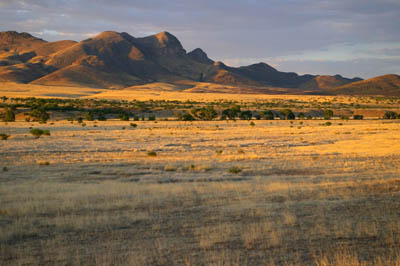To give you a deeper sense of our Nature and History at the Nation's Edge summer institute, we have posted our preliminary daily schedule, including institute readings and recommended resources, below. This preliminary schedule is subject to change. You will soon be able to download the complete preliminary detailed schedule and readings as a .pdf file.
WEEK ONE
WEEK TWO
WEEK THREE - Field Study
Monday, 29 June
After breakfast, we’ll make sack lunches, check out of the Southwest Research Station and head south back into the grasslands ecosystem. We will visit John Slaughter Ranch, 15 miles east of Douglas, Arizona, where Dr. Marsha Weisiger will lead a seminar on the history of the ranch and the impacts of Slaughter’s cattle empire on the grasslands of the U.S.-Mexico border, based on her own research. This ranch, now a historic museum and national wildlife refuge, is located along the international border, directly north of the Sonoran ranch where we will be heading at the end of the day. Both ranches were part of the original land grant of 73,240 acres which Slaughter purchased in 1884. After his death in 1922, his widow sold the Mexican and US portions to different people. (Although a dirt road connects the two sites, we will need to retrace our path back to Douglas and head south to the official border crossing at Agua Prieta.) At the John Slaughter Ranch, we will begin our exploration of the local use of the border as refuge over time: for Chiricahua Apaches during the Indian wars; for Mormons escaping anti-polygamy laws of the 1880s; for Chinese laborers eluding immigration border agents in the late 19th and early 20th centuries; for smugglers, soldiers and refugees of the Mexican Revolution; for Mexican ranchers seeking to avoid the imposition of restrictions on their cattle. After we cross the border at Agua Prieta, we’ll drive to San Bernardino Ranch, Sonora, owned by Cuenca Los Ojos Foundation, where we’ll settle into housing accommodations for a 2-night stay. In the evening, Valer Austin will present a powerpoint talk on the history of the ranch and the ongoing environmental restoration efforts.
Readings: Reba N. Wells, “Cora Viola Howell Slaughter: Southern Arizona Ranchwoman,” Journal of Arizona History 30 (Winter 1989): 391-416; John Russell Bartlett, Personal Narrative of Explorations and Incident, vol. 1, pp. 241-60.
Recommended: Douglas S. Watson, ed., The Santa Fe Trail to California, 1849-1852: Journal and Drawings of H.M.T. Powell; John G. Bourke, An Apache Campaign in the Sierra Madre.
Tuesday, 30 June
Taking advantage of the relative coolness of the morning, Dr. Weisiger and ranch owner and Foundation director Valer Austin will conduct an outdoor seminar during which we’ll head back to the border we had seen from the north just the day before. We’ll continue our exploration of the local use of the border as refuge over time, drawing on the readings to interrogate the landscape’s pasts; our visits include the ruins of a military camp, and the Mormon house site of the Slaughter’s foreman who sought to evade US anti-polygamy laws by building a home that straddled the border. After a brunch under the trees, we'll head to a natural riverine oasis and hot springs where we'll spend the afternoon. There we will explore both natural and human-made alterations of the border environment as we discuss the impact of the 1887 Sonora earthquake in the region. The Rodman reading will help us open up a discussion about restoration practices through an exploration of the inherent difficulties in defining “native” and “exotic.” There will be time for reading, reflection and relaxation in the afternoon. After an outdoor bbq we'll head back to our bunkhouse accommodations.
Readings: John Rodman, “Restoring Nature: Natives and Exotics,” In the Nature of Things, pp. 139-53; Max Suter, "Contemporary Studies of the 3 May 1887 M 7.5 Sonora, Mexico (Basin and Range Province) Earthquake," Seismological Research Letters, 77 (March/April 2006).
Recommended: Cormac McCarthy's Border Triology, All the Pretty Horses, The Crossing, Cities of the Plain; Susan M. DuBois and Ann W. Smith, The 1887 Earthquake in San Bernardino Valley, Sonora: Historic Accounts and Intensity Patterns in Arizona, excerpts.
Wednesday, 1 July
Leaving the ranch lands behind, we’ll pack up and head west along the border to Agua Prieta. There we will explore the legacy of the Mexican Revolution in this border town. Plutarco Elías Calles and Lázaro Cárdenas, two future presidents of Mexico, both lived in the town during its early years. During the Revolution, Pancho Villa’s 1916 night attack on the town was repelled by the forces of Álvaro Obregón, assisted by large searchlights powered by American electricity. The 1920 Plan de Agua Prieta, signed in a curiosity shop near the international border, called for the repeal of the government headed by Venustiano Carranza. The army headed by Álvaro Obregón eventually deposed Carranza. We have arranged visits to a local ejido—communal farms created in the 1930s under the agrarian reforms set in motion by the Mexican Revolution--and other urban-agricultural interfaces. We’ll stay at the Hotel Plaza, Agua Prieta, Sonora, overnight.
Readings: Miguel Tinker Salas, “Between Cultures: Towns on the Line,” In the Shadow of Eagles, pp. 162-75; Mary Rak, Cowman’s Wife, pp. 1-17, 121-29; David Yetman, “Of Cowboys and the Cattle Business,” in Sonora: An Intimate Geography, pp. 95-107.
Recommended: Steven E. Sanderson, Agrarian Populism and the Mexican State: The Struggle for Land in Sonora.
|
